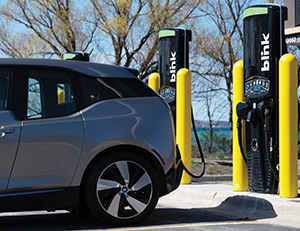 Brendan Jones,
Brendan Jones,
president, Blink Charging
Staying ahead of EV trends has proven elusive for many retailers, and it’s little wonder why. A decade ago, just over 100,000 electric vehicles were sold worldwide each year. Last year, that number had surged more than 50-fold, with 10% of global car sales electric, a four-fold jump from just two years prior.
You know this, of course, as you scan the roadways each day and see lanes swelling with Teslas, Rivians and even Ford F-150s. NACS Magazine’s forecast from just a few years ago in these pages was one of cautious investment (“staying ahead of a potential shift in fuel type consumption could provide long term benefits”); however, that tepid prescription has taken on a more critical urgency today. The question is not whether EVs will happen or what their impact could be. It’s whether you’re prepared for a fuel transition that’s growing exponentially with a momentum that promises to sideline those who...well...remain on the sidelines.
With that in mind, we reached out to Blink Charging to determine the business opportunities associated with EV charging, and the available options should a retailer decide to join the EV (r)evolution and implement chargers at their station.
STIMULUS CHECKS
At a very high level, the U.S. government is now actively involved in stimulating an EV charging infrastructure. The bipartisan Infrastructure and Investment and Jobs Act (IIJA) allocates $7.5 billion to help build 500,000 electric vehicle chargers, with $4.75 billion of that total to be allocated to the states as part of the National Electric Vehicle Infrastructure (NEVI) Program ($2.5 billion will be distributed through a competitive grant program). The NEVI program is designed to help states create a network of EV charging stations along interstate highways.
“The president’s bipartisan infrastructure law will help us win the EV race by working with states, labor, and the private sector to deploy a historic nationwide charging network that will make EV charging accessible for more Americans,” said U.S. Transportation Secretary Pete Buttigieg in announcing the plan.
States applied individually to access funds from NEVI (the deadline was August 1, 2022), and any convenience store that installs super-fast chargers along designated interstates or major highways could apply for funding. Plan logistics are still being finalized, with more information expected by September 30.
“Applying for funds from your state’s NEVI allocation can be complex,” said Brendan Jones, president of Blink Charging. “To maximize a station’s share of proceeds, we encourage owners to work with their charging representative. Most should be deeply involved with each state’s planning committee and understand their application process.”
 MONEY MAKERS
MONEY MAKERS
Federal funding can no doubt help ease the financial burden associated with EV charging deployment, though due diligence is still necessary to ensure practicality and a sustainable ROI. “While all forecasts point to increased adoption across the U.S., stations located in rural areas face numerous challenges,” Jones said. “For instance, a lot of rural locations don’t have extra electrical capacity with the utilities.”
Additionally, it’s imperative to understand current and future demand trends to see if the financial investment makes bottom-line sense. That investment includes myriad hard and soft costs, including legal (it’s critical to understand your state’s public utility regulations), construction, maintenance, promotion, real estate, hardware, software, cable, grid upgrades, regulatory compliance and labor, among dozens of others.
While the investment is sizable for any location, that’s not to say that your station must assume those costs. For that—and for any EV infrastructure deployment—a retailer will work with a charging service provider that offers electric vehicle service equipment (EVSE), selecting a business model that aligns with their EV goals.
PICK A MODEL. ANY MODEL.
“The first thing we look at is infrastructure,” Jones said. “We need to understand space and the physical wiring that needs to be done. That’s a reflection of the physical layout, but that assessment also goes toward understanding the type of charging technology.”
There are two main charger types: Level 2 chargers, which work best for workplaces and residential units, and which can take five hours or more to reach a usable charge level; and DCFC, or fast chargers, which can charge a car over 80% in as little as 15 minutes.
“After that top-level assessment, we present to the operator three operating models. The first is where the EVSE owns the equipment (third-party owner-operator). The second is where the host owns the equipment (owner-operator). And the third is where the EVSE and host share ownership (this model is not available from all EVSEs).
“Any useful ROI projection must look at the various business models to determine the right fit. For an operator with multiple stores, different models may be more practical depending on their size and location.”
Third-party operator
In a third-party operator model (TPO), the EVSE takes care of nearly all costs associated with the installation and operation of the charging station. It develops the site, works to secure all necessary permits and typically leases space in the operator’s parking lot to operate the station. Any fees (see sidebar on page 73) are collected by the TPO, who shares revenues or pays a fee to the station owner.
This model relieves the retailer from most build out and maintenance costs, as well as from cumbersome interactions with utility companies. With such an agreement, the retailer cedes a certain amount of control over the customer experience, which is assumed by the EVSE.
Additionally, with the TPO calling the operating shots, the retailer gives up the majority of the revenue potential of the charging station. NOTE: This model is not available from all EVSEs.
Owner-operator
In an owner-operator model, the retailer purchases the EV equipment from a EVSE and then hires a contractor to install it. As such, the retailer assumes nearly all costs for construction, operation and maintenance.
In such an arrangement, the retailer retains full control over pricing and the customer experience, as well as revenue derived from the stations. “While the retailer assumes a majority of the responsibility associated with running the charging station, the EVSE should be a primary point of guidance in working through the issues associated with the deployment, such as utility usage and regulatory compliance,” Jones said.
Shared owner-operator
In a shared owner-operator model, the EVSE and retailer split the investment costs while sharing in the revenues. “It’s not a standard model, but it’s one we offer to retailers, as it offers a generous balance of risk and reward,” Jones said. It’s just one way that Blink demonstrates its commitment to finding flexible solutions that help each retailer achieve individual success. “While some companies sell their equipment and make money solely from networking fees and maintenance, our options incorporate sustainable buy-in from the EVSE.” It’s an approach he says that promotes the long-term operation and maintenance of EV charging infrastructure while avoiding stranded assets.
BACK TO THE FUTURE
With the EV marketing growing exponentially, the wait-and-see game (for most) is no longer an option. More important today is selecting a model that makes (dollars and) sense, thereby fully leveraging the opportunities that an electrically charged customer base presents for your company.
Money Matters
Commensurate with each business model are separate considerations for customer fees.
Gratis: In the free model, customers pay...well...nothing. The service is offered free to lure traffic or serve a larger customer need.
De minimis: Some retailers choose to assess modest fees that simply cover their operational costs. This can be viewed as a loss leader, as the retailer seeks to lure customers to their store with the hope that they will generate in-store sales revenue while customers recharge their vehicles.
Ka-ching: Others may look to charging stations as a stand-alone profit center, with fees that align with energy consumption. If you’re looking to beef up your bottom line, keep in mind that DC fast chargers can be costly to operate.
The success of each depends on the unique factors associated with each store, such as location, customer demographics and more.